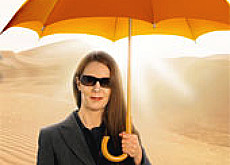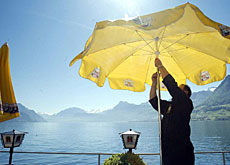Population urged to save their skins

Monday is National Skin Cancer Day in Switzerland, an event aimed at raising awareness of the disease and showing people how to protect themselves from the sun.
In Switzerland 15,000 people are year are affected by skin cancer – one of the highest number of cases in Europe – but the disease can be treated if caught early enough.
The day – the second of its kind – has been organised by the Swiss Cancer League and the Swiss Association of Dermatology and Venereology. Similar events are taking place in 15 other countries across Europe.
For many people, summer means enjoying the sunshine and the outdoors. But not everyone takes into account the effects of the sun’s harmful rays on their skin.
Switzerland has the second-highest rate of skin cancer in Europe after Norway. Of the 15,000 Swiss cases, 1,600 have malignant melanoma, the most dangerous form of the cancer.
The Swiss Cancer League estimates that between five and ten per cent of the Swiss population have a high risk of developing skin cancer.
These are people who are fair-skinned, have lots of moles and whose family has already been affected by the disease, or those who have already had skin cancer.
Also at risk are people who often suffered severe sunburn as children and those who regularly expose themselves to harmful ultraviolet (UV) rays without protection – either in the sun or on a sunbed.
Cases doubled
The number of cases of the disease has more than doubled in the past 20 years – a situation that is worrying health professionals and the government.
“As they are well-off, the Swiss tend to go on holiday more times a year than other people and therefore expose their skins more often to harmful UV rays,” Barbara Iseli, the Swiss Cancer League’s spokeswoman, told swissinfo.
“At work they don’t go out very much and if they do, they choose the worst possible moment, namely during the midday lunchbreak, when the sun is at its most dangerous,” she said.
Added to this is the fact that the risk of severe sunburn is particularly acute in the Swiss Alps, as UV radiation levels are higher in the mountains than on the plains.
Iseli says that all too often people do not take UV protection advice seriously, such as moving into the shade during the hottest parts of the day, covering up and wearing a hat when outside for long periods of time or using a proper suncream.
These good habits are difficult to instil into the population, she admits.
However, the number of deaths each year from skin cancer has remained fairly stable in recent years at around 220.
Crucial early diagnosis
“Compared with the past, people are much more aware of the problem and therefore go to the doctor earlier,” Iseli said.
“This is of vital importance because if diagnosed in time, skin cancer is curable in 90 per cent of cases.”
Raising awareness of prevention measures is crucial, which is why the league and the Swiss Association of Dermatology and Venereology have supported National Skin Cancer Day. Other events are taking place internationally where the event is also known as Melanoma Monday.
The Swiss campaign is encouraging the population to assess their skin cancer risk by completing a questionnaire which is available in 400 pharmacies across the country or on the website www.melanoma.ch.
If necessary, dermatologists are on hand to check out for free any suspect areas of skin.
In 2006 the campaign ran over a whole week and was very effective.
“We examined around 10,000 people and diagnosed 177 melanomas,” said Iseli. “A great success which we are certain can be increased even more this year.”
swissinfo
Basal cell carcinoma
The most common form of tumour affecting the skin (around 90% of cases), mostly affecting people aged over 50. While not normally fatal, it can cause disfigurement. If caught early enough, it can be treated.
Squamous cell carcinoma
This may appear as nodules or as red, scaly patches of skin which may increase rapidly. It is the second-most common skin cancer found in Caucasians and is usually found on fair-skinned people. Although generally more aggressive than basal cell carcinoma, this cancer is highly treatable.
Melanoma
This the most dangerous form of the disease because it can spread to other parts of the body. Contrary to the other forms of skin cancer, young people can be affected as well. However, if caught early enough, this rare form of skin cancer can be cured.

In compliance with the JTI standards
More: SWI swissinfo.ch certified by the Journalism Trust Initiative









You can find an overview of ongoing debates with our journalists here . Please join us!
If you want to start a conversation about a topic raised in this article or want to report factual errors, email us at english@swissinfo.ch.